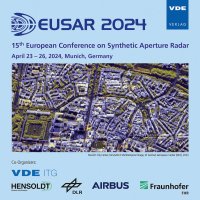Enhanced Estimation and Validation of Ocean Surface Radial Velocity using Sentinel-1 TOPS IWSLC Data
Konferenz: EUSAR 2024 - 15th European Conference on Synthetic Aperture Radar
23.04.2024-26.04.2024 in Munich, Germany
Tagungsband: EUSAR 2024
Seiten: 6Sprache: EnglischTyp: PDF
Autoren:
Iqbal Ahmed, Usman; Rabus, Bernhard; Geudtner, Dirk
Inhalt:
Measuring the Doppler Centroid Anomaly (DCA) of Single Look Complex (SLC) SAR data is a powerful resource to estimate Ocean Surface Radial Velocity (OCN-RVL). The Sentinel-1 Ocean Surface Radial Velocity (S-1 OCN RVL) product derived from Interferometric Wide Swath (IW) Terrain Observation with Progressive Scan (TOPS) mode data was designed to increase both accuracy and resolution compared to the previously available ENVISAT-ASAR product. However, while theoretically better, the S-1 OCN RVL products available on the ESA Copernicus open access hub in practice have been plagued by strong processing artifacts manifesting as discontinuities within sub-swaths and bursts of the IW data. Moreover, the available S-1 OCN RVL products are also uncalibrated due to obvious non-zero velocities over land areas. Simon Fraser University (SFU) is working with the European Space Agency (ESA) to improve the ocean surface velocity estimation from Sentinel-1 IW TOPS SLC data. We propose a novel algorithm for S-1 IW TOPS SLC based Dopler Centroid Anomaly data that robustly exploits the continuity constraints for the Doppler signature surface across bursts and sub-swaths to generate a smooth and enhanced Ocean Surface Radial Velocity product. To assess the validity of our approach we perform a cross comparison with ocean surface radial velocity products derived from RADARSAT-2 Moving Object Detection Experiment (MODEX-1). A total of twelve co-incident acquisitions for Sentinel-1 IW TOPS and RADARSAT-2 Modex-1 mode at six different sites across the world were collected for this purpose. Here, we present a preliminary result for a data collection over Bay of Fundy on 6th July 2020. Our proposed method produces a continuous ocean radial velocity map that is both free of discontinuities and quantitatively agrees more closely with the simultaneous corresponding RS-2 ATI and DCA based maps compared to the existing S-1 OCN RVL product.


